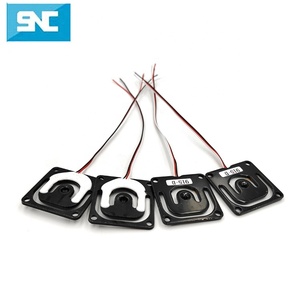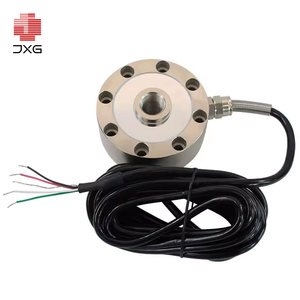
All categories
Featured selections
Trade Assurance
Buyer Central
Help Center
Get the app
Become a supplier

(2417 products available)














































Strain Gauge Transducers
The most common weight transducers are strain gauge transducers, which operate by attaching a strain gauge to a support element such as a beam or platform. When weight is applied, the material deforms and the strain gauge detects minute changes in the surface electrical resistance. These changes are translated into an electronic signal proportional to the weight, hence the need for a digital scale. Strain gauges possess high accuracy and sensitivity and are compatible with a variety of construction.
Hydraulic Transducers
Hydraulic transducers utilize liquid to measure weight. A platform with an attached sealed container filled with liquid is utilized. As the weight is applied, the liquid level changes and creates pressure that is proportional to the applied weight. Pressure sensing elements then convert this pressure into an electrical signal. Common applications for these transducers include heavy-duty weighing in areas that are dirty or have explosive risks where multi weight sensor are preferred.
Pneumatic Transducers
Pneumatic transducers work in a way that is similar to hydraulic ones, but in this case, air is used instead of liquid. They measure weight by creating pressure changes on a provided deck that is caused by a weighted object's set of enclosed chambers with air in between. These transducers measure weight by measuring the pressure exerted by the air underneath the platform. Although not as common as strain gauge or hydraulic transducers, they are found in applications with explosive risk hazards that require operations in environments with less liquid.
Load Cells
Load cells are designed electrical devices that convert an object's mass into the mechanical energy that gets transformed into electrical signals. They normally comprise metal alloy elements whose resistance changes when they undergo deformation. There are many applications of load cells, such as industrial scales, trucks scales, and testing equipment. In today's market, some are wireless to enable easy transfer of data in various applications.
Capacitive Transducers
Capacitive transducers function by measuring changes in capacitance caused by an object's presence between two capacitor plates. The plates' distance or dielectric constant will be affected by the object, and the weight will be reflected as capacitance change. These transducers handle small weight changes with high precision, making them ideal for such applications as laboratories or pharmaceutical.
Built with Strong Materials
The inner workings of weight sensors includes strain gauges and load cells that are developed from hard materials like stainless steel or aluminum alloys. These guarantee resistance to deformation, fatigue, and wear that may develop over time as force is applied. Apart from this, stainless steel is also used for its property of corrosion resistance to damage, which ensures long-term reliability out in the elements.
Water Resistance Ratings
Weight transducers come with IP ratings or ingress protection ratings, which refer to the transducers' test results under water and dust exposure conditions. Devices with higher rated numbers (for example, IP67) are dust proof and survive immersion in water at a depth of around 1m for a maximum of 30 minutes. Such ratings expand the lifespan of transducers in environments that are dirty or wet.
Temperature Extremes
Extreme heat and extreme cold are detrimental to transducer performance. Materials expand or contract under heat or cold extremes, and electrical components can degrade due to overheating. A weight transducer that can withstand temperature fluctuations will have in it some heat-resistant housings and the circuitry will be designed to function even in extreme ambient temperatures, thus maintaining its integrity in harsh environments.
Vibration and Shock Resistance
Transducers installed in mobile applications such as trucks or construction equipment are designed to absorb sudden shocks and constant vibrations. Additional damping elements are mounted on the transducers, which minimize the energy transmission between the measured load and the transducer. This ensures that frequent movement does not adversely affect any readings and does not affect the lifespan.
Tight Load Cycles
Some industrial areas have to bear the repetition of many thousands of loads daily. In such situations, the transducer's life can be drastically shortened if it is not designed for that purpose. Wireless weight scales Designed to combat exhaustion over excessive load typically will include fatigue-resistant components and strong materials that will not yield even with extended periods of usage.
Industrial Weighing Systems
In industry, weight transducers are integral to process automation and efficiency improvement. They are embedded in weighing scales and batch processing equipment for materials such as food ingredients, chemicals, and construction materials. They help to control over and under filling by providing accurate measurements, such as reducing waste, minimizing cost, and increasing production time.
Agricultural Applications
Agriculture utilizes weight transducers in the process of monitoring crop yields, measuring fertilizer and water usage, and even animal tracking systems. They are installed on trucks and farm equipment to provide farmers with vital data.M There data helps in making decisions about planting, harvesting, and resource allocation. It also reduces labor-intensive field activities, thereby increasing efficiency.
Transportation and Logistics
Weight transducers carry large-scale applications in transportation and logistics. They are used to measure cargo on vehicles to avoid overloads for safety and legal compliance. Indeed, many roads and bridges have safety overloads, and having an on-board transducer checks this. Also, in truck scales, weight transducers are employed in weigh stations for accurate weight measurement of trucks and freight cars.
Healthcare Equipment
In this field, weight transducers are significant components of various devices like body weight scales, dosage dispensers, and infant incubators. Due to their accuracy and sensitivity, weight transducers can help measure small weight changes, which is important for medication and patient monitoring. In addition, accuracy plays an important role in patient safety and treatment effectiveness.
Construction and Civil Engineering
Moreover, weight transducers in construction are fitted on cranes, load monitors, and structural health systems to measure the load being carried within structures and vehicles. This data is important in risk assessment and safety measures. In load cell scales , employed during construction, keep track of the materials used such as concrete and steel to ensure compliance with the set standards.
Type of Application
The transducer type that best fits an application's nature should be the primary criterion for selection. Strain gauge transducers for general use offer the best in for industries, while hydraulic transducers work best in areas exposed to dirty and hazardous elements. Capacitive transducers suit the best small-scale and high-precision laboratory work. Identifying the weighting location and its purpose leads to the selection of a sensor suited for the task.
Capacity and Range
Ensure that the selected transducer has the proper weight capacity and range for the specific purpose intended. The measuring range of the transducer must be compatible with the load it will measure.Expected overload or underload results in fatal inaccuracies, hence the need for proper range selection to avert this.
Sensitivity and Accuracy
In critical measurements, sensitivity and accuracy become important factors in the selection process. Sensitivity indicates the smallest weight change that can be detected, while accuracy denotes the degree of the correct measurement. High-precision transducers are required in the pharmaceutical and laboratory industries. Less rigorous industries can work with standard accuracy transducers.
Environmental Conditions
Environmental hazards like dirt, water, temperature, and explosive elements affect the choice of a transducer. It should feature environmental protection, such as IP-rated housings, corrosion-resistant materials, and extreme temperature functioning capabilities, if installed outside and in such hazardous environments.
Interface and Compatibility
The transducer to be selected must be compatible with other data acquisition systems, displays, and instruments. An adequate interface, e.g., amplifiers or signal conditioners, should be available to ensure proper functioning. Cross-compatibility eliminates the need for additional devices for transducer integration into the existing system.
Also known as a weight sensor, a weight transducer converts the mechanical load into electrical signals.Some applications include industrial weighing systems, truck scales, batch processing, farming trucks, healthcare gadgets, structural monitors in construction, and monitoring cargo in transportation.
Most weight transducers use a strain gauge bonded to a metal frame. When weight is applied, the frame distorts slightly, causing the strain gauge to change resistance. This is then converted to an electrical signal proportional to the weight measured.
Many weight transducers have IP-rated housings that keep off water, dust, and other environmental hazards. The transducers come with waterproof ratings, such as IP67, to ensure performance in wet and dusty environments.
Many weight transducers are designed to operate in outdoor conditions whilst accounting for all weather elements. They have protective casings against water, dust, extreme heat, and frost.
A properly protected and maintained transducer can survive for quite a long time. Corrosion-resistant materials and housings that protect against environmental hazards increase the lifespan of the transducer to several years.